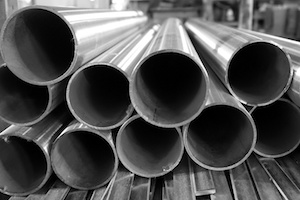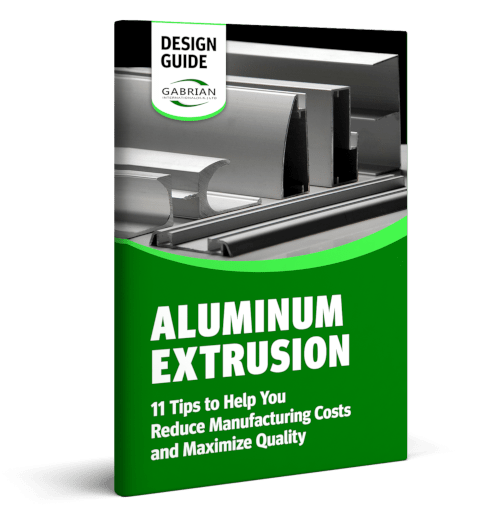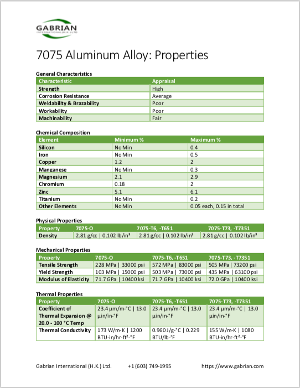7075 Aluminum: Get to Know its Properties and Uses
Alloy selection is important for extrusion projects, and in the aerospace industry, the 7075 aluminum alloy is commonly used.
With zinc as it’s primary alloying element, it is exceptionally strong. A member of the 7000 series, it is one of the strongest alloys available and is comparable to many types of steel. Although it has high strength, it has lower corrosion resistance than other common aluminum alloys and does not offer the same levels of machinability or weldability.
Due to its high strength, it is often used in applications where it will come under high stress such as aircraft wing spar and ground support equipment.
Here are Some General Characteristics of 7075
This alloy features high strength, with average corrosion resistance, poor weldability and workability. It is also fairly machinable. Download a PDF of its characteristics and material properties.
| Characteristic | Appraisal |
|---|---|
| Strength | High |
| Corrosion Resistance | Average |
| Weldability & Brazability | Poor |
| Workability | Poor |
| Machinability | Fair |
This alloy is generally solution heat treated to further enhance its high-strength properties.
Material Properties of 7075-O, 7075-T6, 7075-T73 Aluminum
Some of the most common tempering options for this alloy are O, T6, and T73.
Physical Properties of 7075 Aluminum
Here we can see the density of the alloy. Note that there is no difference in density between the different tempers.
| Property | 7075-O | 7075-T6, -T651 | 7075-T73, -T7351 |
|---|---|---|---|
| Density | 2.81 g/cc | 0.102 lb/in³ | 2.81 g/cc | 0.102 lb/in³ | 2.81 g/cc | 0.102 lb/in³ |
Mechanical Properties of 7075 Aluminum
Here we can see the tensile strength, yield strength, and modulus of elasticity for the alloy in the -O, -T6, and -T73 conditions.
| Property | 7075-O | 7075-T6, -T651 | 7075-T73, -T7351 |
|---|---|---|---|
| Tensile Strength | 228 MPa | 33000 psi | 572 MPa | 83000 psi | 505 MPa| 73200 psi |
| Yield Strength | 103 MPa | 15000 psi | 503 MPa | 73000 psi | 435 MPa | 63100 psi |
| Modulus of Elasticity | 71.7 GPa | 10400 ksi | 71.7 GPa | 10400 ksi | 72.0 GPa | 10400 ksi |
Thermal Properties of 7075 Aluminum
Here we can see some thermal properties of the alloy including the coefficient of thermal expansion and thermal conductivity. The Annealed, T6, and T73 conditions are included.
| Property | 7075-O | 7075-T6, -T651 | 7075-T73, -T7351 |
|---|---|---|---|
| Coefficient of Thermal Expansion @ 20.0 - 100 °C Temp | 23.4 µm/m-°C | 13.0 µin/in-°F | 23.4 µm/m-°C | 13.0 µin/in-°F | 23.4 µm/m-°C | 13.0 µin/in-°F |
| Thermal Conductivity | 173 W/m-K | 1200 BTU-in/hr-ft²-°F | 0.960 J/g-°C | 0.229 BTU/lb-°F | 155 W/m-K | 1080 BTU-in/hr-ft²-°F |
Note: The material properties above have been pulled from Matweb, here, here, and here. Please note that they cannot be 100% verified.
Now, you may be wondering about the composition of the 7075 alloy.
Chemical Composition of 7075 Aluminum
This alloy is part of the 7000 series of alloys. As such, its major alloying element is zinc. Zinc is added to increase strength. It also contains chromium and copper. Here we can see the guidelines for the chemical composition of 7075 aluminum.
| Element | Minimum % | Maximum % |
|---|---|---|
| Silicon | No Min | 0.4 |
| Iron | No Min | 0.5 |
| Copper | 1.2 | 2 |
| Manganese | No Min | 0.3 |
| Magnesium | 2.1 | 2.9 |
| Chromium | 0.18 | 2 |
| Zinc | 5.1 | 6.1 |
| Titanium | No Min | 0.2 |
| Other Elements | No Min | 0.05 each0.15 in total |
Now that we’ve seen the chemical composition of 7075, let’s talk about how the alloy compares to some other key options.
Comparing 7075 Aluminum to Other Alloys
The 7075 alloy is often chosen for applications that require high strength, but you may be considering other options for your particular application. Below are some other common alloys that are often considered as alternatives.
7075 vs 2024
 Much like the 7075 alloy, 2024 aluminum is commonly used in aerospace applications. In particular, it is often used in aircraft wings and fuselages. It’s high strength lends well to these applications. 2024 is suited to applications where high cyclic fatigue resistance is required. Whereas, 7075 is suited to applications that require high stress/strain resistance.
Much like the 7075 alloy, 2024 aluminum is commonly used in aerospace applications. In particular, it is often used in aircraft wings and fuselages. It’s high strength lends well to these applications. 2024 is suited to applications where high cyclic fatigue resistance is required. Whereas, 7075 is suited to applications that require high stress/strain resistance.
Both of these alloys offer similar weldability. Spot or flash welding can be used, but arc and gas welding are not recommended. They also both offer similar machinability. 2024 has slightly better workability, while 7075 has slightly better corrosion resistance.
6061 vs. 7075
 6061 aluminum is commonly referred to as “structural” aluminum. It is often used in construction and is commonly used to extrude aluminum bars, pipes, rods, and tubes. It is also highly versatile, being used for bicycle frames, electrical fittings, and heat sinks. It has better general characteristics than 7075, with higher corrosion resistance, weldability, and machinability. But it does not have the same high strength that 7075 aluminum has. Where strength is the most important consideration, 7075 can be the optimal choice. Learn More »
6061 aluminum is commonly referred to as “structural” aluminum. It is often used in construction and is commonly used to extrude aluminum bars, pipes, rods, and tubes. It is also highly versatile, being used for bicycle frames, electrical fittings, and heat sinks. It has better general characteristics than 7075, with higher corrosion resistance, weldability, and machinability. But it does not have the same high strength that 7075 aluminum has. Where strength is the most important consideration, 7075 can be the optimal choice. Learn More »
Summary
The most important benefit of 7075 aluminum is its high strength. While it does not have the same level of corrosion resistance or weldability that other common alloys due, its resistance to stress and strain makes it highly useful in aerospace applications where it allows for weight savings over steel.
Download our 7075 aluminum properties PDF to keep as a reference.
Also, if you’d like to learn more about how to optimize your part design for the extrusion process, download our Aluminum Extrusion Design Guide.
Aluminum Extrusion Design Guide
Aluminum extrusions can be designed to fit a wide range of products used in various industries. But product designers often have difficulty achieving optimal extrusion profile design and reducing manufacturing costs.
In this guide, we provide 11 tips to help you optimize your designs for the extrusion process.


